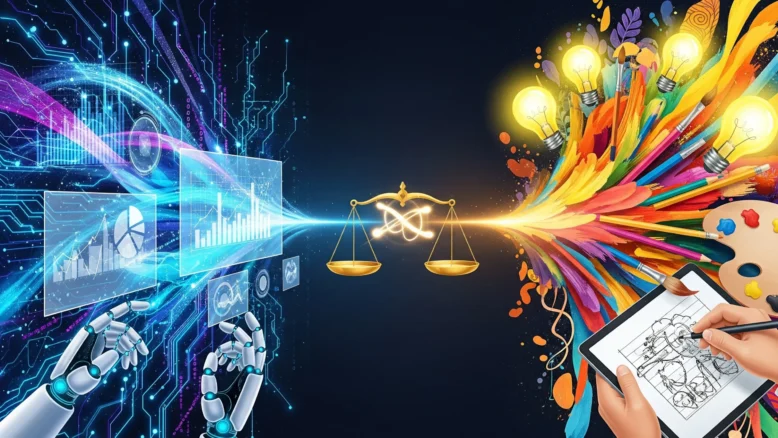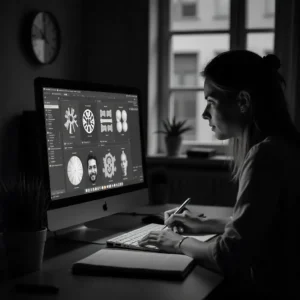
Top 10 Insights on Balancing AI Efficiency and Human Creativity
Businesses and creators are turning to AI tools to get more done in less time. But while technology can handle repetitive tasks and data analysis, human creativity is still the key to innovation and original ideas. Balancing AI efficiency with human insight is not just a trend, it’s becoming an important skill for anyone who wants to stay competitive. By finding the right mix, you can let AI handle routine work while focusing your energy on strategy, storytelling, and problem-solving. The goal is to work smarter, not just faster, and make the most out of both human and machine strengths.
This balance also opens the door to more flexible and creative workflows. Teams can experiment with new ideas without getting bogged down by repetitive tasks, and decision-making becomes faster with AI-supported insights. Learning to balance AI efficiency and human creativity means knowing when to rely on technology and when to trust your instincts. It’s about collaboration between man and machine, where each complements the other. In the following sections, we’ll share the top 10 insights that can help you achieve this balance and improve both productivity and creativity in your work.
Balancing AI Efficiency with Human Ideas
 AI tools are powerful at handling repetitive and time-consuming tasks. They can organize data, generate reports, or perform calculations faster than any human could. However, human ideas bring creativity, problem-solving, and innovation that AI cannot fully replicate. Balancing AI efficiency with human input means knowing which tasks to let AI handle and where humans need to step in. This balance allows teams to focus on strategy, design, and new ideas while leaving routine work to machines. When done correctly, it creates a workflow that is both productive and creative.
AI tools are powerful at handling repetitive and time-consuming tasks. They can organize data, generate reports, or perform calculations faster than any human could. However, human ideas bring creativity, problem-solving, and innovation that AI cannot fully replicate. Balancing AI efficiency with human input means knowing which tasks to let AI handle and where humans need to step in. This balance allows teams to focus on strategy, design, and new ideas while leaving routine work to machines. When done correctly, it creates a workflow that is both productive and creative.
To make the most out of this balance, consider these tips:
- Let AI handle repetitive or data-heavy tasks to save time.
- Use human insight for tasks that require critical thinking or creativity.
- Encourage team members to suggest ideas that AI might not generate.
- Review AI-generated results carefully to ensure they align with your goals.
- Experiment with combining AI suggestions with human input for fresh solutions.
Encourage Collaboration Between AI and People
 Collaboration between AI and people can bring out the best in both technology and human talent. AI can handle repetitive work, analyze data, and provide insights quickly, while humans can focus on creativity and decision-making. Encouraging collaboration means designing workflows where both AI and team members contribute their strengths. When people and AI work together, projects become faster, more accurate, and more innovative. It also helps reduce mistakes that may occur when relying on only one side, if it’s human or machine. Creating a culture that values both perspectives is key to long-term success.
Collaboration between AI and people can bring out the best in both technology and human talent. AI can handle repetitive work, analyze data, and provide insights quickly, while humans can focus on creativity and decision-making. Encouraging collaboration means designing workflows where both AI and team members contribute their strengths. When people and AI work together, projects become faster, more accurate, and more innovative. It also helps reduce mistakes that may occur when relying on only one side, if it’s human or machine. Creating a culture that values both perspectives is key to long-term success.
Here are some practical tips to encourage this collaboration:
- Assign routine or repetitive tasks to AI so humans can focus on creative work.
- Use AI insights as a starting point, then let humans refine or improve them.
- Encourage team discussions on AI-generated results to explore new ideas.
- Train employees on how to use AI tools effectively alongside their own skills.
- Celebrate successes where AI and humans worked together to achieve better results.
Use AI to Explore New Ideas Faster
 AI can be a powerful tool for testing and exploring new ideas quickly. It can generate multiple options, simulate outcomes, or analyze trends much faster than manual methods. This allows teams to experiment without investing excessive time or resources. Using AI in this way doesn’t replace human creativity, it supports it by giving you a starting point and opening possibilities you might not have considered. When you combine AI suggestions with human insight, you can refine ideas and develop solutions more efficiently. The key is to see AI as a partner in creativity rather than a replacement.
AI can be a powerful tool for testing and exploring new ideas quickly. It can generate multiple options, simulate outcomes, or analyze trends much faster than manual methods. This allows teams to experiment without investing excessive time or resources. Using AI in this way doesn’t replace human creativity, it supports it by giving you a starting point and opening possibilities you might not have considered. When you combine AI suggestions with human insight, you can refine ideas and develop solutions more efficiently. The key is to see AI as a partner in creativity rather than a replacement.
Here are some tips to explore new ideas faster with AI:
- Use AI to generate multiple concepts or variations of a project quickly.
- Analyze trends or patterns with AI to identify new opportunities.
- Combine AI suggestions with your own creativity for unique solutions.
- Test ideas with AI simulations before committing to a full project.
- Keep reviewing and adjusting based on human feedback to ensure quality results.
Focus on Work That Adds Real Value
 Balancing AI efficiency means knowing which tasks truly require human attention and which can be handled by technology. AI can take over repetitive, time-consuming work, allowing humans to focus on activities that have a real impact on your goals. Tasks like strategy planning, problem-solving, and creative development are areas where human input makes the biggest difference. By prioritizing high-value work, you ensure that your time and energy contribute meaningfully to projects. This approach also prevents burnout and helps teams stay engaged with work that matters most.
Balancing AI efficiency means knowing which tasks truly require human attention and which can be handled by technology. AI can take over repetitive, time-consuming work, allowing humans to focus on activities that have a real impact on your goals. Tasks like strategy planning, problem-solving, and creative development are areas where human input makes the biggest difference. By prioritizing high-value work, you ensure that your time and energy contribute meaningfully to projects. This approach also prevents burnout and helps teams stay engaged with work that matters most.
Here are some tips to focus on work that adds real value:
- Let AI handle routine or repetitive tasks to free up human effort.
- Identify tasks that directly impact results or client satisfaction.
- Allocate human resources to creative, strategic, or decision-making work.
- Regularly review workflows to see which activities can be automated.
- Encourage team members to focus on problem-solving and innovation.
Track Performance and Adjust Smartly
 Tracking performance is a key step in balancing AI efficiency with human creativity. Even the best AI tools need oversight to ensure they are producing accurate and useful results. Monitoring performance helps you spot errors, understand what is working well, and identify areas for improvement. It also allows humans to make adjustments where AI may fall short, keeping projects on track. By combining AI data with human insight, you can make smarter decisions and improve both efficiency and creativity. Regular review ensures that AI remains a helpful partner rather than a source of mistakes or wasted effort.
Tracking performance is a key step in balancing AI efficiency with human creativity. Even the best AI tools need oversight to ensure they are producing accurate and useful results. Monitoring performance helps you spot errors, understand what is working well, and identify areas for improvement. It also allows humans to make adjustments where AI may fall short, keeping projects on track. By combining AI data with human insight, you can make smarter decisions and improve both efficiency and creativity. Regular review ensures that AI remains a helpful partner rather than a source of mistakes or wasted effort.
Here are some tips to track performance and adjust smartly:
- Set clear goals and metrics to measure both AI and human contributions.
- Regularly review AI outputs for accuracy and relevance.
- Use human judgment to refine AI suggestions and correct errors.
- Make adjustments to workflows based on results and feedback.
- Encourage team discussions to identify areas where AI or human input can improve.
Balancing AI Efficiency in Everyday Tasks
 AI can be a valuable helper for managing everyday tasks that are repetitive or time-consuming. From organizing emails and scheduling meetings to analyzing basic data, AI can handle many routine activities efficiently. Balancing AI efficiency in these tasks allows humans to focus on work that requires creativity, decision-making, and problem-solving. When used correctly, AI frees up time and reduces stress, making daily workflows smoother and more productive. It’s important to know which tasks AI can manage well and which still need a human touch to maintain quality. This balance helps teams work smarter and prevents unnecessary effort on low-impact tasks.
AI can be a valuable helper for managing everyday tasks that are repetitive or time-consuming. From organizing emails and scheduling meetings to analyzing basic data, AI can handle many routine activities efficiently. Balancing AI efficiency in these tasks allows humans to focus on work that requires creativity, decision-making, and problem-solving. When used correctly, AI frees up time and reduces stress, making daily workflows smoother and more productive. It’s important to know which tasks AI can manage well and which still need a human touch to maintain quality. This balance helps teams work smarter and prevents unnecessary effort on low-impact tasks.
Here are some tips to balance AI efficiency in everyday tasks:
- Let AI handle scheduling, reminders, and repetitive data entry.
- Use AI to quickly summarize reports or emails for easier review.
- Keep humans in control of tasks that need judgment or creativity.
- Review AI results regularly to ensure accuracy and relevance.
- Adjust AI usage based on workflow needs and team feedback.
Balancing AI Efficiency by Focusing on Skills AI Cannot Replace
 While AI can handle many tasks, there are skills that only humans can bring to the table. Critical thinking, creativity, empathy, and strategic decision-making are areas where human input is important. Developing these skills ensures that your work remains valuable, even as AI takes over routine or repetitive tasks. Focusing on these uniquely human abilities allows you to complement AI rather than compete with it. By investing in skills AI cannot replace, you increase your adaptability and keep your work relevant in a technology-driven world.
While AI can handle many tasks, there are skills that only humans can bring to the table. Critical thinking, creativity, empathy, and strategic decision-making are areas where human input is important. Developing these skills ensures that your work remains valuable, even as AI takes over routine or repetitive tasks. Focusing on these uniquely human abilities allows you to complement AI rather than compete with it. By investing in skills AI cannot replace, you increase your adaptability and keep your work relevant in a technology-driven world.
Here are some tips to develop skills AI cannot replace:
- Practice problem-solving and critical thinking regularly.
- Improve communication and collaboration skills for teamwork.
- Learn storytelling and creative expression to enhance ideas.
- Focus on empathy and understanding to make human-centered decisions.
- Continuously upgrade knowledge and expertise in your field.
Encourage Experimentation with AI Tools
 Experimenting with AI tools can open up new possibilities and help teams find innovative solutions faster. AI allows you to test different approaches without spending excessive resources, making trial and error less risky. By trying out various AI features, you can discover methods or ideas you might not have considered otherwise. Encouraging experimentation also helps teams become more comfortable with AI, building confidence in using technology effectively. This approach ensures that AI becomes a tool for creativity rather than just a replacement for routine tasks.
Experimenting with AI tools can open up new possibilities and help teams find innovative solutions faster. AI allows you to test different approaches without spending excessive resources, making trial and error less risky. By trying out various AI features, you can discover methods or ideas you might not have considered otherwise. Encouraging experimentation also helps teams become more comfortable with AI, building confidence in using technology effectively. This approach ensures that AI becomes a tool for creativity rather than just a replacement for routine tasks.
Here are some tips to encourage experimentation with AI tools:
- Test different AI features on small projects before using them on larger tasks.
- Combine AI suggestions with your own ideas to explore unique solutions.
- Encourage team members to share insights from their AI experiments.
- Learn from both successes and failures to improve workflows.
- Keep an open mind and allow flexibility in how AI is applied.
Create a Culture That Supports Balance
 Building a culture that supports both AI efficiency and human creativity is key to long-term success. When teams value both technology and human insight, they are more likely to use AI effectively without losing originality. A supportive culture encourages collaboration, experimentation, and continuous learning. It helps people see AI as a tool that enhances their work rather than a replacement for their skills. Leaders play an important role in setting expectations and guiding teams to balance productivity with creativity. Over time, this approach creates an environment where both AI and humans thrive together.
Building a culture that supports both AI efficiency and human creativity is key to long-term success. When teams value both technology and human insight, they are more likely to use AI effectively without losing originality. A supportive culture encourages collaboration, experimentation, and continuous learning. It helps people see AI as a tool that enhances their work rather than a replacement for their skills. Leaders play an important role in setting expectations and guiding teams to balance productivity with creativity. Over time, this approach creates an environment where both AI and humans thrive together.
Here are some tips to create a culture that supports balance:
- Promote collaboration between AI tools and team members on projects.
- Recognize and reward both human creativity and smart AI use.
- Provide training on how to use AI tools effectively.
- Encourage open communication and sharing of ideas and feedback.
- Lead by example and demonstrate how to balance AI efficiency with human input.
Balancing AI Efficiency Without Losing Human Touch
 Even as AI handles more tasks, maintaining the human touch is important for meaningful and impactful work. While AI can process data, organize information, and generate suggestions quickly, humans bring empathy, intuition, and personal judgment that technology cannot replicate. Balancing AI efficiency without losing human touch means knowing when to rely on machines and when human input is necessary. This approach ensures that work remains both accurate and emotionally intelligent, keeping interactions, decisions, and creative output relatable and valuable. By integrating human oversight into AI-driven processes, teams can achieve better results without losing authenticity.
Even as AI handles more tasks, maintaining the human touch is important for meaningful and impactful work. While AI can process data, organize information, and generate suggestions quickly, humans bring empathy, intuition, and personal judgment that technology cannot replicate. Balancing AI efficiency without losing human touch means knowing when to rely on machines and when human input is necessary. This approach ensures that work remains both accurate and emotionally intelligent, keeping interactions, decisions, and creative output relatable and valuable. By integrating human oversight into AI-driven processes, teams can achieve better results without losing authenticity.
Here are some tips to maintain the human touch while using AI:
- Review AI-generated outputs to ensure they align with human goals and values.
- Keep humans involved in decision-making and final approvals.
- Use AI to support rather than replace creative or personal work.
- Encourage feedback from team members or clients to maintain authenticity.
- Balance efficiency with thoughtful human judgment in every project.
Conclusion
Finding the right balance between AI efficiency and human creativity isn’t just a tech trend; it’s a game-changer for how we work. When AI handles routine tasks, humans have more time to focus on ideas, problem-solving, and strategies that really matter. This partnership can make work faster, smarter, and more innovative while keeping the personal touch that machines can’t replicate. Now, we’d love to hear from you, how do you use AI in your daily work, and what challenges have you faced in keeping your human creativity alive? Share your experiences in the comments and let’s learn from each other’s approaches. Together, we can explore the best ways for humans and AI to thrive side by side.
Read Next: How to Make Attractive AI Product Photos for Ecommerce Shops





